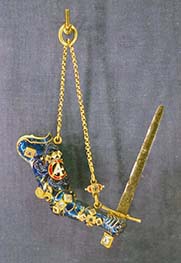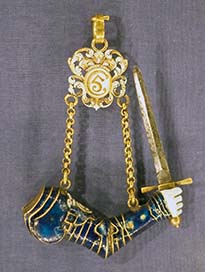After the Kalmar War against Sweden (1611-1613), King Christian IV decided to reward those noblemen who had distinguished themselves in the war. As a result the Order of the Armed Fist was instituted on December 2nd, 1616.
On the day of the institution 12 persons (all noblemen) were knighted. This is the only known bestowal.
 An example of a badge of the order
An example of a badge of the order
(Rosenborg Castle)
The 12 knights were:
- Christen Friis
- Albret Skeel
- Jørgen Lunge
- Breide Rantzau
- Gert Rantzau
- Anders Bille
- Ditlev Rantzau
- Anders Sinklar (Andrew Sinclair)
- Jens Sparre
- Marqvardt Pentz
- Ulrik Sandberg
- Jørgen Skeel
The badge of the order is possibly manufactured and delivered in 1617, as the known badges carry this date.
In 1634 King Christian IV offered the two remaining knights (Christen Friis and Albret Skeel) to exchange the order with the
Order of the Elephant.
The badge of the order
The badge is a blue enamelled arm in gold set with diamonds and carrying an iron sword. The badge is worn from a blue ribbon around the neck (connected to the badge with two gold chains).
 'Prototype' of a badge of the order
'Prototype' of a badge of the order
with the monogram of King Christian V
(Rosenborg Castle)
Three preserved badges are known to exist - one badge resides in the collection at Rosenborg Castle and another at the Museum of National History at Frederiksborg Castle in Hillerød.
The third badge (pictured in Berghman) is in an unknown private collection.
Rosenborg Castle also has 'prototype' badges with the monogram of King Christian V, which indicates that at some point it was considered to revive the order.
There are no known statutes for the order.
Sources:
Grandjean, H.F "De Kongelige Danske Ridderordener" (1903)
Stevnsborg, Lars "Kongeriget Danmarks Ordener, Medaljer og Hæderstegn" (2005)
Berghman, Arvid "Nordiska Ordnar och Dekorationer" (1949)